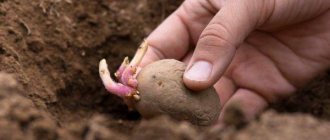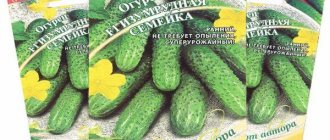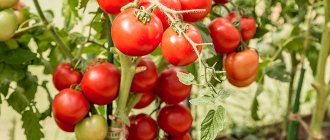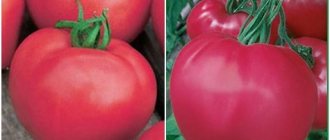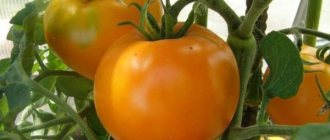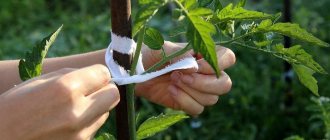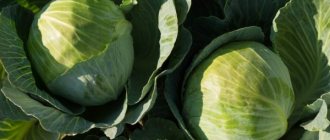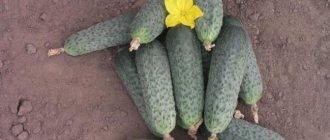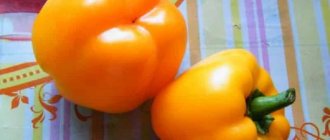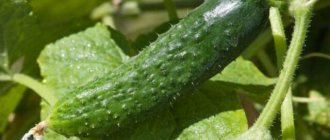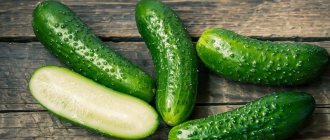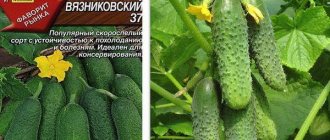Lenara F1 is a hybrid of high-quality Dutch cucumbers of the new generation. Its distinctive features are excellent yield, fresh pleasant taste, disease resistance and ease of care.
| Landing location | Ripening time | Mode of application | Fruit length | Group | Fruit smoothness | Pollination method |
| Universal | Early ripening (35-45 days) | Salad | Medium - from 10 to 15 cm | Hybrid | Highly lumpy | Parthenocarpic |
Description of the variety
Cucumber "Lenara F1" is a parthenocarpic hybrid of the gherkin type. Refers to early ripening varieties that are resistant to temperature changes. It is grown both in open ground and in various types of greenhouses.
The growing season of Lenara is 40-45 days.
The fruits grow up to 13 cm, 3 cm in diameter, weighing up to 120 g. The shape is an elongated ellipse with small tubercles and white spines (see photo). Zelentsy are approximately the same size. The color is dark green with longitudinal stripes of light color. The skin is loose, the flesh is juicy, aromatic and crispy, not bitter. Cucumbers are more of a salad type. They have a long shelf life, good presentation, and are easy to transport.
The bushes of this variety grow powerful, medium in size, with small lateral shoots. The root system of cucumbers grows well. The foliage is dark green, not dense. 3-4 cucumbers are formed in one leaf axil. It can grow in shady areas and can withstand unfavorable environmental factors. Characterized by early fruiting and high yield.
The yield under favorable conditions reaches 17 kg/sq.m. You can pick cucumbers until the beginning of autumn.
Early cucumber for salads
This first generation hybrid is produced by the Dutch company Rijk Zwaan, known for its high-quality seeds. Many farms purchase seed material from this manufacturer, growing delicious cucumbers in winter greenhouses.
In the description, we especially note that the Lenara hybrid is recommended for cultivation in the North-West region, as it tolerates unfavorable weather conditions, is shade-tolerant and produces stable yields.
Obtained as a result of painstaking selection work, the hybrid is parthenocarpic, distinguished by its power and strong growth (indet). The stem has shortened internodes and side shoots of medium length.
Only female flowers are formed on the plant, with up to 3 fruits in the axil. Lenara's cucumbers are ellipsoidal, up to 11-13 cm long, beautiful and even. The color of the skin is dark green, with a lighter shade at the very top. There are small tubercles on the surface of the cucumbers, medium pubescence, and white spines.
The pulp of greens is dense, juicy, with a very pleasant taste and aroma. The cucumbers are crunchy, and there are very few seeds inside.
Read also: Kanzashi sunflowers master class
The hybrid belongs to salad cucumbers; the first greens can be picked after 40-41 days.
Positive traits
Lenara cucumber has the following advantages:
- early ripening;
- does not require pollination by bees;
- fruit uniformity;
- decent taste;
- high productivity;
- shade tolerance;
- unpretentiousness;
- the fruits do not overgrow and do not turn yellow;
- resistance to some pumpkin diseases.
The variety is less susceptible to powdery mildew, cucumber mosaic virus, and olive spot.
The characteristics of this type of cucumber are at the highest level, although there are also negative aspects: they are consumed mainly fresh; overgrown fruits can become compacted, barreled and lose their taste.
Video
Despite the high resistance of the cucumber hybrid “Lyutoyar F1” to diseases, the plants require timely treatment against pests. You can find out how to carry out such processing by watching the video:
About the author:
Found a mistake? Select the text with the mouse and click:
Ctrl + Enter
Do you know that:
“Frost-resistant” varieties of garden strawberries (more often simply “strawberries”) need shelter just as much as ordinary varieties (especially in those regions where there are snowless winters or frosts alternating with thaws). All strawberries have superficial roots. This means that without shelter they freeze to death. Sellers’ assurances that strawberries are “frost-resistant,” “winter-hardy,” “tolerates frosts down to −35 ℃,” etc. are deception. Gardeners must remember that no one has yet managed to change the root system of strawberries.
Growing
Cucumber "Lenara F1" is suitable for growing in greenhouses and open ground. For winter greenhouses, seedlings are planted at the end of January. And for growing in open ground - in mid-May. In this case, the sprouts should have time to get stronger, i.e. put out 3-4 true leaves. After transplanting to a permanent place, it is recommended to maintain a temperature of +20 degrees for the first 2-3 days.
Thanks to the seedling growing method, fruiting of cucumbers begins much earlier.
The trellis method greatly facilitates harvesting and helps to grow strong cucumber bushes. The optimal distance between trellises is 100-120 cm, between holes – 40-45 cm. It is advisable to pinch the main stem. Before planting the plant, the soil should be moistened and fertilized with mineral fertilizers.
How to care?
Northern regions are characterized by high air humidity. This has a beneficial effect on cucumbers. To retain water in the soil, use sawdust or sand. Additionally, sawdust mulch with the addition of ash is placed around the bushes.
For cucumbers that are in a greenhouse, watering is carried out once a week. The frequency of approaches for plants that develop on the ground depends on weather conditions. Watering is carried out as necessary. When the soil dries out, it needs to be loosened.
If the bed is high, then the bushes are sprinkled with a mixture of humus, ash and crushed pine needles. This is a good food for cucumbers, which is rich in microelements and vitamins. The mixture is also used for plants in standard garden beds.
Crushed egg shells are added to it to compensate for the lack of potassium for plants. Potassium salts are necessary for the normal development of the root system. Mineral fertilizers include superphosphate, potassium nitrate, and potassium chloride. Administration rate 250 ml/bush.
Take one of the fertilizers in an amount of 20 g and dilute it in 10 liters of warm water. Fertilizers can be applied to the garden bed and watered. In this case, the norm is 20 g/m2.
To ensure that leaves and stems grow well, use a mixture of humus. If the leaves turn yellow, then saltpeter is scattered in the garden bed; use any nitrogen fertilizer with potassium, calcium, ammonia. The rate of administration remains the same.
To strengthen the buds and ovaries, Lenara f1 cucumbers are sprayed with 5% boric acid solution. It increases the period of fruiting, accelerates the ripening of greens, and destroys pathological microflora.
Instead of boric acid, use "MagBor" or "Borogum". To increase productivity, complex fertilizers “Rodnichok”, “Kristalon”, “Fasco” are introduced:
- cucumbers of the Lenara f1 variety, which are located in open ground, often suffer from insects. As a preventive measure, the biological product “Fitoverm” is used. It is diluted at a rate of 10 ml/l. This amount is enough to process plants on 1 acre of land;
- From folk recipes for insects, an infusion of onion peels is used. It is used for both adult and young plants;
- If cobwebs appear on the leaves, then there is a risk of cucumbers being infected with spider mites. As a prophylaxis, “Kleshevit” is used, 2 ml/l;
- The drug “Danadim”, 2 ml/10 l, is effective against aphids.
Dill, cilantro, and basil are planted in the beds. Herbs repel many insects with their smell. Near the cucumber bed you can place flower beds with fragrant flowers. They will prevent infection of vegetables from cucumber beetles, whiteflies, and sprout flies.
Slugs often appear on cucumbers. They eat the peel and pulp of the fruit, leaving behind a trail of mucus. Pathological microflora can develop in it. After slugs, cucumbers suffer from bacteriosis. To get rid of shellfish, use an infusion of red pepper or boric acid solution.
The cucumber variety Lenara f1 is in demand among gardeners in Karelia, Murmansk, and Arkhangelsk regions. Greenhouses are built in for them or beds are laid out in the garden. Agricultural technology is standard.
It is necessary to monitor soil moisture, introduce fertilizing, and take preventive measures against diseases and insects. Gherkins look attractive and have a sweetish taste.
Care
Caring for Lenara F1 is not difficult, however, according to reviews from gardeners, cucumbers of this variety are often affected by aphids. Therefore, it is worthwhile to protect the harvest in advance using folk remedies. Stir 400 g of shag and 80 g of laundry soap in a bucket of water. Spray the plant with this solution 1-2 times a week. If traditional methods are powerless, you can resort to chemicals (“Decis”, “Metofos”, etc.).
Recommendations for caring for Lenara cucumbers:
- evening watering (3-4 times a week);
- fertilizing with fertilizers (5-6 times per season);
- weeding beds;
- do not thicken the planting;
- Pick ripe fruits on time.
Diseases and pests
This variety is quite resistant to diseases and pests, but in Russia many garden farmers are faced with the defeat of the decay hybrid, which can cause significant damage to the quality and quantity of the crop.
The disease is identified by curled leaves and fallen flowers. To protect plants from pests, folk remedies will help:
- Soap solution with shag - 400 g, shag and 80 g of soap per bucket of water.
- In this case, onion peels are effective - half a bucket of shells in 10 liters of water, leave for a day and spray the plants.
- You can use chemicals like Decis, Metaphos, Carbophos, but that is if the pest infestation is massive.
Reviews
Due to its youth, Lenara F1 has not yet received many reviews, but has already found its fans.
“I planted this variety quite early, in January. Then I illuminated the seedlings. It does not require much attention, but the fruits grow by leaps and bounds. Loves mineral fertilizers. Cucumbers are tasty and juicy. We start eating cucumbers before everyone else. I planted it both in the greenhouse and in the garden, there is no difference in taste. I can confidently advise.” Lyudmila, 56 years old.
“This is not the first time I’ve planted this variety and I’m very pleased. Taste and harvest are what you need. Last year we endured a cold spell, but the harvest was not damaged in any way. But the aphids, of course, attacked, my proven methods helped. All fruits are almost the same size, not very large. Description and methods of cultivation are on the packaging. The manufacturer is already known in Russia; all the seeds from this company germinate in 9 cases out of 10. I’m happy with the cucumbers.” Nikolai, 42 years old.
